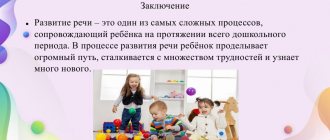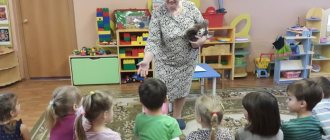Opportunities for developing communication skills of children 4-5 years old
Opportunities for developing communication skills of children 4-5 years old
Recognition of the intrinsic value of preschool age and the attitude towards it as a unique period of personality development determined the task of studying the characteristics of the formation of communicative skills in children aged 3–7 years. In developing this issue, pedagogical practice was based on the concept of activity of L.S. Vygotsky, A.N. Leontyev and psychological and pedagogical research by D.B. Elkonina, A.V. Zaporozhets, V.G. Nechaeva, Ya.L. Kolominsky, A.I. Arzhanova, M.I. Lisina, etc.
M.I. Lisina, A.G. Ruzskaya, Z.M. Boguslavskaya, et al. investigated the relationship between the development of communication skills and the mental development of a preschooler and their influence on the overall level of development of activity. The content and nature of communication between preschoolers and adults was studied by Z.M. Boguslavskaya, S.V. Kornitskaya, M.I. Lisina, A.G. Ruzskaya and others, with peers - L.N. Bashlakova, T.I. Erofeeva, A.A. Royak, B.S. Volkov and N.V. Volkova. The problem of forming a culture of communication was dealt with by T.A. Antonova, M.V. Ilyashenko, N.S. Maletina, S.V. Peterina.
What kind of communication skills can preschoolers aged 4-5 years master? Epishina L.V. , considering the pedagogical aspects of the development of a person’s communicative properties, identifies the following components of the structure of communicative skills of children aged 4–5 years:
- information and communication skills
: the ability to start, maintain and complete communication, to attract the attention of the interlocutor; the ability to navigate partners and communication situations (adequately respond to acquaintances and strangers, understand the intentions and motives of partners’ communication); the ability to use means of verbal and non-verbal communication, to use words and signs of politeness;
- regulatory and communication skills
: the ability to coordinate your actions, opinions, attitudes with the needs of your partners; the ability to help a partner and accept help yourself; ability to resolve conflicts in adequate ways;
- affective-communicative skills
: the ability to notice and adequately respond to the emotional state of a partner; the ability to show sensitivity, responsiveness, and empathy to partners.
In general, it can be noted that the goals and content of children's communication undergo significant changes with age. These theoretical principles made it possible to highlight the features of the formation of communicative skills in children 4-5 years old: children’s assimilation of communicative models occurs in joint activities with an adult. In communicating with adults, he learns how to:
- speak and do the right thing
- listen and understand others
- acquire new knowledge.
At a younger age, schoolchildren are three times more likely to approve of a peer and nine times more likely to enter into conflict relationships with him than when interacting with an adult. In this case, the following prevail:
- effective skills;
- rhetorical skills;
- ability to conduct dialogue;
- the ability to hear and listen and argue;
- the ability to take the point of view of another;
- ability to work together to achieve a common goal.
Along with the need for cooperation between researchers T.A. Repina, R.B. Sterkina highlights the need for recognition by peers. The child learns in communication with peers:
- express yourself
- manage others
- enter into various relationships.
Let us further consider the factors of development of communication skills
preschoolers. For normal development, a child needs not only communication with adults, but also communication with peers. When communicating with a peer, you can observe many actions and addresses that are practically not found in contacts with adults. The child argues with a peer, imposes his will, calms, demands, orders, deceives, regrets.
In preschool age, the leading activity is play. In the formation of a child’s social needs and skills, in his mastering the experience of human activity, the leading role belongs to joint games with peers.
The game simulates real relationships between adults and allows children to comprehend various phenomena of reality. Thus, the game creates favorable conditions for the formation of communication skills (A.P. Usova, R.I. Zhukovskaya, D.V. Mendzheritskaya). The problem of developing communication skills in the process of gaming activity was raised by scientists - psychologists: A.A. Leontyev, G.M. Andreeva, V.S. Mukhina.
The most vivid interaction and communication takes place in small groups - for example, kindergarten groups. One of the factors in the formation of communication skills in children 4-5 years old is a favorable psychological climate in the kindergarten group and in the family. There are groups that are more prosperous than others, with a high level of mutual sympathy and relationship satisfaction, where there are almost no “isolated” children. In these groups, a high level of communication is found and there are almost no children whom their peers do not want to accept into the common game. Value orientations in such groups are usually aimed at moral qualities.
Let's touch on the issue of children with communication difficulties
. What are the reasons for their isolation? It is known that in such cases there cannot be full development of the child’s personality, because the experience of learning social roles is impoverished, the formation of the child’s self-esteem is disrupted, contributing to the development of self-doubt in the child. In some cases, difficulties in communication can cause these children to have an unfriendly attitude towards their peers, anger, and aggression as compensation. A.A. Royak identifies the following characteristic difficulties:
- the child strives for a peer, but is not accepted into the game.
- the child strives for peers, and they play with him, but their communication is formal.
- the child moves away from his peers, but they are friendly towards him.
- the child withdraws from his peers, and they avoid contact with him.
The author explains all these difficulties by the violation of one or all of the following conditions of “full communication”:
- the presence of mutual sympathy;
- presence of interest in the activities of a peer, the desire to play together;
- presence of empathy;
- the ability to “adapt” to each other;
- availability of the required level of gaming skills.
Thus, insufficient knowledge of communication skills is one of the factors in the emergence of difficulties in communication and the further accumulation of these difficulties.
So,
Relationships with other people begin and develop most intensively in preschool age. The first experience of such relationships becomes the foundation on which further personal development is built. How a child’s relationships develop in a peer group largely determines his next path of personal and social development.
To describe the model of formation of communication skills, it is important to determine the criteria for the formation of communication skills in children 4-5 years old: the ability to navigate a communication situation, the use of verbal and non-verbal means of communication, the ability to organize the communication process, overcoming conflicts, the emotional perception of a communication partner.
The elements of effective communication include
- desire to interact with others;
- the ability to organize communication - listen to the interlocutor, empathize emotionally, resolve conflict situations;
- knowledge of the norms and rules that must be followed when communicating with others.
The implementation of the tasks of social and communicative development of preschool children is aimed at gaining experience in various types of children's activities .
- Playful activities make the child feel like an equal member of human society. In the game, the child gains confidence in his own abilities, in the ability to get real results.
- Research activity allows the child to independently find a solution or refutation of his own ideas.
- Fine - allows the child, with the help of work and imagination, to get used to the world of adults, get to know it and take part in it.
- Subject-based – satisfies the child’s cognitive interests at a certain period, helps to navigate the world around him.
- Observation enriches the child’s experience, stimulates the development of cognitive interests, gives rise to and strengthens social feelings.
- Communicative (communication) – unites an adult and a child, satisfies the child’s various needs for emotional closeness with an adult, for his support and evaluation.
- Project - activates the child’s independent activity, ensures the unification and integration of different types of activities.
- Constructive – makes it possible to form complex mental actions, creative imagination, and mechanisms for managing one’s own behavior.
Thus, each type of activity contributes to the process of social and communicative development of preschool children.
The specificity of preschool age is that the social development of a child is carried out under the influence of an adult who introduces the child into society. The child cooperates with competent adults; as a member of society, he is included in the system of human relations, where a dialogue of personalities and value systems takes place. The development of patterns and norms of behavior and the search for correct life attitudes occurs in preschoolers in interaction with peers, teachers, and parents.
Before starting classes on the development of communication skills, as well as subsequently, it is important for teachers to diagnose the communicative development of preschoolers. It consists of conducting a conversation with children, observing them as they complete a task, using preschool didactic material. Communicative development is assessed according to three criteria:
- The child’s knowledge of the rules of communication with people.
- How willingly the child communicates.
- The extent to which a child can listen, resolve conflict situations, and how empathic he is.
Each of these three criteria is assessed using a point system, and as a result, communicative development is assessed at one of three levels: high, low or average.
Children aged 2-3 years are just beginning to master communication skills. A good activity option for them would be to role-play a situation involving going on a visit .
Topic: “To the bunny’s birthday.”
Goal: familiarization with the rules and norms established in society.
Equipment: laptop; loudspeakers; recording a song; toy car; bunny toy; toy gift.



